Description
Suppose the coordinates of 4 side of a rectangle denoted by (x1,y1), (x2,y2),(x3,y3) and (x4,y4). Like this image-

And I have a set of coordinates of 100000 rectangles saved in a txt file. For example here are the values of coordinates of 16 rectangles generated by my code-
#Rect x1 y1 x2 y2 x3 y3 x4 y4 area
1 0.0000 0.0000 0.8147 0.0000 0.8147 0.1355 0.0000 0.1355 0.1104
2 0.8147 0.0000 1.0000 0.0000 1.0000 0.1355 0.8147 0.1355 0.0251
3 0.8147 0.1355 0.9058 0.1355 0.9058 0.8350 0.8147 0.8350 0.0637
4 0.0000 0.1355 0.1270 0.1355 0.1270 0.9689 0.0000 0.9689 0.1058
5 0.9058 0.1355 0.9134 0.1355 0.9134 0.2210 0.9058 0.2210 0.0006
6 0.9058 0.8350 1.0000 0.8350 1.0000 1.0000 0.9058 1.0000 0.0155
7 0.8147 0.8350 0.9058 0.8350 0.9058 1.0000 0.8147 1.0000 0.0150
8 0.1270 0.1355 0.6324 0.1355 0.6324 0.3082 0.1270 0.3082 0.0873
9 0.1270 0.9689 0.8147 0.9689 0.8147 1.0000 0.1270 1.0000 0.0214
10 0.0000 0.9689 0.1270 0.9689 0.1270 1.0000 0.0000 1.0000 0.0040
11 0.9134 0.1355 1.0000 0.1355 1.0000 0.2210 0.9134 0.2210 0.0074
12 0.9134 0.2210 1.0000 0.2210 1.0000 0.8350 0.9134 0.8350 0.0532
13 0.9058 0.2210 0.9134 0.2210 0.9134 0.8350 0.9058 0.8350 0.0047
14 0.6324 0.1355 0.8147 0.1355 0.8147 0.3082 0.6324 0.3082 0.0315
15 0.6324 0.3082 0.8147 0.3082 0.8147 0.9689 0.6324 0.9689 0.1205
16 0.1270 0.3082 0.6324 0.3082 0.6324 0.9689 0.1270 0.9689 0.3339
These coordinates splits an unit square into sub-rectangles like this picture-
Examples of Nearest Rectangles
In the above picture the nearest rectangles for rectangle# 3 are- 9,15,14,1,2,5,13,6 and 7.
For rectangle# 9 they are- 10,4,16,15,3 and 7.
My Problem
Now I would like to calculate the number of nearest rectangles for each of the rectangles using c/c++. How can I do it?
Edit:Based on the responses
#include <iostream>
#include <vector>
#include <fstream>
using namespace std;
struct Rectangle {
double x1, y1;
double x2, y2;
double x3, y3;
double x4, y4;
};
vector<double> get_touching_rectangles(Rectangle base, vector<Rectangle> rectangles) {
for (auto it = rectangles.begin(); it != rectangles.end(); it++) {
Rectangle other = *it;
if (base == other) {
continue; // This is our rectangle... skip it
}
// Top or bottom
if ((other.x2 >= base.x1 && other.x1 <= base.x2) && (other.y1 == base.y3 || other.y3 == base.y1)) {
ret.push_back(other);
continue;
}
// Left or right
if ((other.y3 >= base.y2 && other.y2 <= base.y3) && (other.x1 == base.x3 || other.x3 == base.x1)) {
ret.push_back(other);
continue;
}
}
return ret;
}
int main(int argc, char const *argv[])
{
vector<Rectangle> rectangles;
//parse_txt_file(file, &rectangles); // Or whateer I need to do to parse that .txt file
ifstream inputFile;
inputFile.open("RectCoordinates.txt");
//std::vector<Rectangle> touching =
get_touching_rectangles(rectangles.at(2) /* Rectangle #3 */, rectangles);
inputFile.close();
return 0;
}
Ok I write the above code based on the responses. But it is showing the following error-
g++ -std=c++11 st5.cpp -o ssst5.cpp: In function ‘std::vector<double> get_touching_rectangles(Rectangle, std::vector<Rectangle>)’:
st5.cpp:23:21: error: no match for ‘operator==’ in ‘base == other’
st5.cpp:23:21: note: candidates are:
In file included from /usr/include/c++/4.7/iosfwd:42:0,
from /usr/include/c++/4.7/ios:39,
from /usr/include/c++/4.7/ostream:40,
from /usr/include/c++/4.7/iostream:40,
from st5.cpp:1:
/usr/include/c++/4.7/bits/postypes.h:218:5: note: template<class _StateT> bool std::operator==(const std::fpos<_StateT>&, const std::fpos<_StateT>&)
/usr/include/c++/4.7/bits/postypes.h:218:5: note: template argument deduction/substitution failed:
st5.cpp:28:13: error: ‘ret’ was not declared in this scope
st5.cpp:33:13: error: ‘ret’ was not declared in this scope
st5.cpp:37:12: error: ‘ret’ was not declared in this scope
What am I doing wrong?